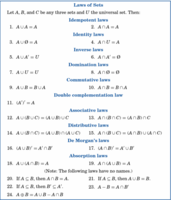bushra1175
Junior Member
- Joined
- Jun 14, 2020
- Messages
- 59
I was looking at this example in the textbook and I don't understand how the expression changed from the second-last to the last line using the laws of sets (please see the purple arrow). I have included the laws of sets in the textbook for reference. I understand all the laws used up until that point.



I'm struggling to identify which law was applied as the results don't match any. All help will be greatly appreciated.



I'm struggling to identify which law was applied as the results don't match any. All help will be greatly appreciated.
